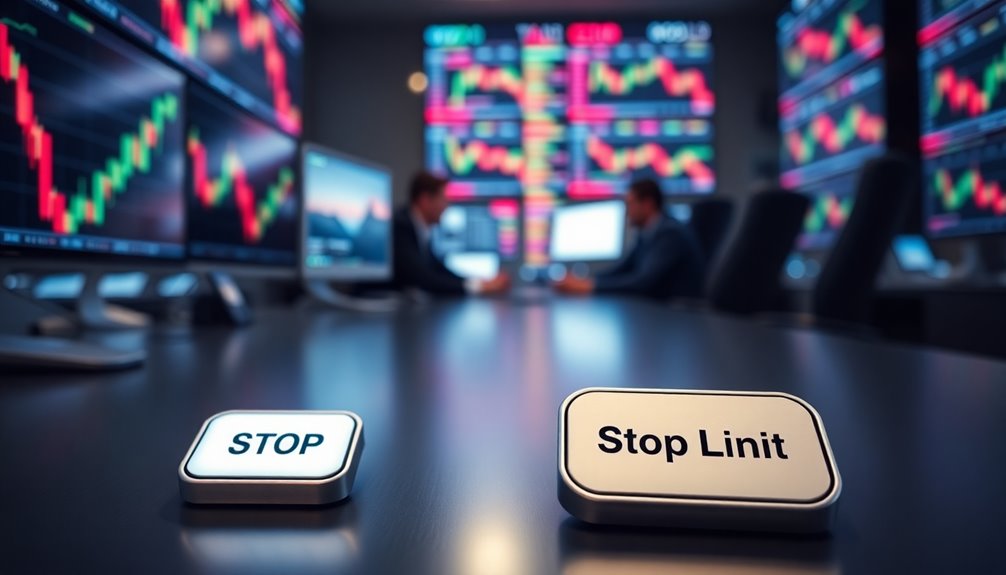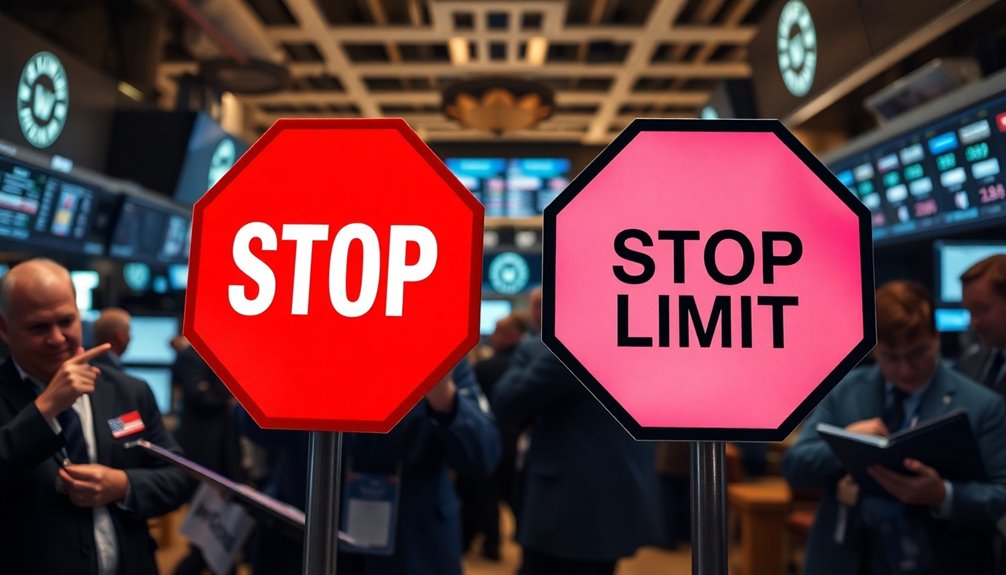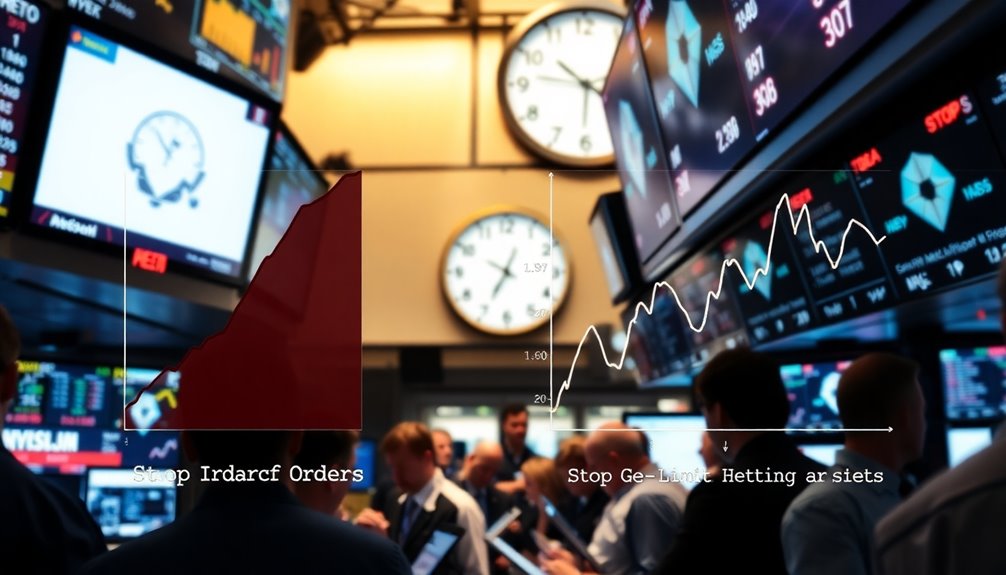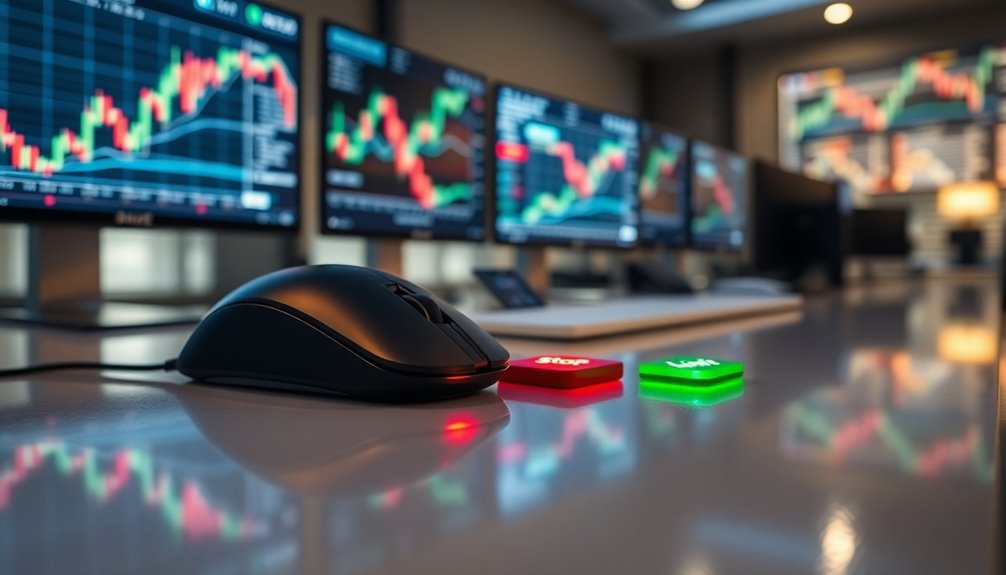A stop order triggers a market order when a specific price is reached, ensuring quick execution, while a stop-limit order activates a limit order at the same price, giving you control over the execution price. With stop orders, you risk slippage during volatile moments, meaning you might end up with a less favorable price. In contrast, stop-limit orders might not execute at all if the limit price isn't met, offering control but adding complexity. Each order type has its advantages and drawbacks, and the best choice often depends on market conditions and your investment strategy. There's more to explore on this topic.
Key Takeaways
- A stop order triggers a market order once a specified stop price is reached, ensuring immediate execution at the current market price.
- A stop-limit order activates a limit order when the stop price is hit, allowing traders to control the execution price but risking non-execution.
- Stop orders can experience slippage during high volatility, potentially executing at unfavorable prices, while stop-limit orders avoid this but may not fill at all.
- Stop orders are simpler to use and suitable for fast markets, whereas stop-limit orders offer greater price control but add complexity.
- Market conditions affect both order types; stop orders may execute rapidly, while stop-limit orders may face delays or failures during volatile periods.
Order Types Explained

When you trade stocks, understanding the different order types is essential for effective decision-making. Stop orders activate when a stock reaches a specified stop price, turning into a market order that executes at the next available price. While they guarantee execution, market volatility can lead to unfavorable prices. In contrast, types of orders are standardized, providing a range of choices for execution.
On the other hand, stop-limit orders also trigger at a stop price but become limit orders instead. This means they only fill at a specified limit price or better, giving you more control over execution. However, there's a risk they mightn't be filled if the market price doesn't reach the limit.
Both types help manage risk but serve different trading strategies. Choose wisely based on your trading goals.
Order Types Overview

Understanding order types is crucial for navigating the stock market effectively, as each type serves a distinct purpose in your trading strategy.
Stop orders trigger a market order once the specified stop price is reached, ensuring execution but not the exact price. They're great for limiting losses or protecting profits, although you might end up with a worse price due to market volatility.
On the other hand, stop-limit orders combine features of both stop and limit orders. They trigger a limit order when the stop price is hit, ensuring execution only at your specified limit price or better. Stop-loss orders are essential for limiting potential losses in volatile markets, making them a valuable tool in your overall risk management strategy.
While stop orders guarantee execution, stop-limit orders offer more control over prices, making them ideal for precise trading strategies.
Order Execution Mechanics Explained

Order execution mechanics play a vital role in how your trades are processed once you've selected the right order type.
When you place a stop order, it activates when the asset hits your specified stop price. A stop-loss order turns into a market order, ensuring quick execution at the current market price. Conversely, a stop-limit order becomes a limit order, allowing for greater price control but lacking execution guarantees if the market moves rapidly. In volatile markets, slippage can affect stop-loss orders, while stop-limit orders protect against it by ensuring execution at or above your limit price. Your trading platform and market conditions also impact how efficiently your orders are executed, as the execution speed of your broker's order processing can significantly influence the outcome of your trades.
Pros and Cons

While both stop and stop limit orders serve the purpose of managing trades effectively, they come with their own sets of advantages and disadvantages.
Stop orders are great for automatic execution and provide liquidity, but they can suffer from slippage and may trigger on short-term market fluctuations.
On the other hand, stop limit orders give you control over the execution price, helping manage risk. However, they can be complex and mightn't execute in low liquidity situations. This execution control is especially beneficial for traders looking to optimize their trade outcomes.
Ultimately, understanding these pros and cons can help you choose which order type aligns best with your trading strategy, ensuring you make informed decisions that suit your investment goals.
Stop vs. Stop Limit Orders

When deciding between stop and stop limit orders, it's essential to grasp how each type functions to meet your trading needs.
A stop order activates as a market order once the stop price is reached, ensuring execution but not the price. In contrast, a stop limit order combines a stop and limit order, activating only when the stop price is hit but executing at the specified limit price or better. This means you can avoid unfavorable prices, but execution isn't guaranteed. Additionally, using stop orders can help manage risk effectively in trading situations.
You can use buy and sell stop orders or their limit counterparts for both long and short positions. Remember, your brokerage might've specific rules, so check their fee structure and order management options.
Market Volatility Impacts Execution

Market volatility significantly affects how your trades are executed, especially during periods of high trading activity. In volatile markets, you might experience delays in order execution, meaning your trades can be filled at prices far from what you expected. This happens as market makers may shift to manual execution methods, causing queues and backlogs. Psychological factors such as investor fear can also lead to heightened volatility, impacting trade execution. Wider spreads and increased price fluctuations can drive up your trading costs, particularly during the first hour of trading. If you place market orders, there's a risk they'll be executed at prices that differ significantly from the quoted price. Limit orders mightn't fill even if the security trades at your desired price due to order imbalances, further complicating execution during these turbulent times.
Algorithmic Trading Strategies Evolving

As technology advances, algorithmic trading strategies are evolving to leverage sophisticated tools that enhance trading performance.
With AI and ML integration, you can make dynamic adjustments to your stop-loss and stop-limit orders based on real-time market analysis and historical volatility. These technologies utilize predictive indicators to refine execution precision, optimizing your trading outcomes. Understanding the execution differences between stop-loss and stop-limit orders is crucial for effective strategy implementation.
Reinforcement learning continuously adapts to new data, ensuring your stop levels maximize returns while minimizing risks. Advanced statistical models further enhance your strategies, allowing you to anticipate volatility changes effectively.
As you navigate trading, combining these advanced features empowers you to manage risks better, aligning your strategies with market conditions and your individual risk tolerance.
Set Clear Price Triggers

Setting clear price triggers is vital to executing your trading strategy effectively.
With stop orders, you set a stop price that, once reached, triggers a market order for immediate execution. However, keep in mind that the execution price may differ, especially in volatile markets, so there's no guarantee. Additionally, stop orders do not guarantee execution, which can leave traders vulnerable in fast-moving markets where market volatility can affect order fulfillment.
On the other hand, stop-limit orders provide a dual trigger mechanism, where the stop price initiates a limit order, allowing you to define the maximum or minimum execution price. This gives you more control but poses the risk of non-execution if the market moves past your limit.
Frequently Asked Questions
Can I Use Stop Orders in Options Trading?
Yes, you can definitely use stop orders in options trading! They help you manage your risk by automatically triggering a market order when the price reaches a specified level.
This way, you can protect your investments without constantly monitoring the market. Just remember, while stop orders provide quick execution, they don't guarantee a specific price.
If you want more control, consider incorporating stop limit orders into your strategy as well.
How Do Stop Orders Affect My Trading Strategy?
Stop orders can significantly impact your trading strategy by providing a safety net for your investments.
They help you exit positions quickly to limit losses or lock in profits without needing to monitor the market constantly.
However, since they execute at the market price once triggered, you mightn't get your desired exit price.
Understanding when to use stop orders can enhance your risk management and make your trading more disciplined and effective.
Are Stop Limit Orders Available for All Asset Types?
Stop limit orders aren't available for all asset types.
While you can use them for stocks and ETFs, their availability varies for derivatives like options. Some markets may not support these orders due to liquidity issues.
You should check with your brokerage firm, as specific platforms may have different rules.
Always consider the market conditions, since high volatility can affect whether your stop limit order gets filled at your desired price.
What Platforms Support Stop and Stop Limit Orders?
Imagine flipping through your favorite trading app like it's a magazine.
Many platforms support stop and stop-limit orders, including major brokerage firms like Fidelity and TD Ameritrade.
Online platforms like Robinhood and E*TRADE also offer these features, with mobile apps for convenience.
Specialized trading software, such as MetaTrader and Thinkorswim, provides advanced tools for experienced traders.
Just be sure to check each platform's specific rules and fees before diving in!
Can I Cancel a Stop Order After It's Placed?
Yes, you can cancel a stop order after it's placed. Just make sure to do it before it triggers.
You'll typically use your trading platform or broker to cancel it manually.
Keep in mind that it's best to avoid making hasty decisions when canceling, as emotional reactions can lead to unnecessary market exposure.
Always check your account to ensure the cancellation is processed successfully and stay aware of current market conditions.
Conclusion
In summary, understanding the difference between stop and stop limit orders can empower your trading decisions. By recognizing how each order type works, you can manage risk more effectively. Whether you're aiming to protect profits or limit losses, you'll navigate market volatility with confidence. Set clear price triggers, evaluate your strategies, and adapt to changing conditions. With the right tools and knowledge, you'll be better positioned to seize opportunities and enhance your trading success.









